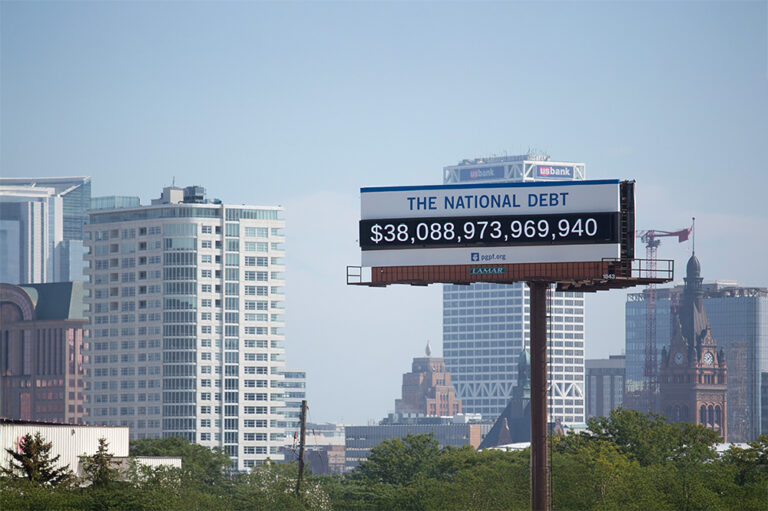Today, the Congressional Budget Office (CBO) updated their budget and economic projections, emphasizing a fact that has been known for some time: The United States is on an unsustainable fiscal course marked by large and rising deficits. CBO’s report comes at a key time as lawmakers this year will be faced with a range of critical fiscal decision points, including the debt ceiling, a government funding deadline, and the expiration of trillions in tax cuts.
A key part of that challenging outlook is that mounting debt and higher interest rates have pushed up interest payments, which threatens to crowd out other priorities. And it is critical that lawmakers act soon to address the debt and get the United States on a sustainable fiscal path.
Below are some key takeaways from the report:
1. The national debt is expected to exceed its record high in just four years.
Debt held by the public was 98 percent of gross domestic product (GDP) in 2024. However, by 2029, the structural mismatch between spending and revenues, along with higher interest payments, will cause federal debt to rise above the nation’s all-time high of 106 percent, which was reached just after World War II. CBO projects that debt will continue rising, reaching 118.5 percent of GDP by 2035.
2. Deficits will remain high over the 10-year period.
CBO projects that the annual budget deficit will rise over the next 10 years, climbing from $1.7 trillion in 2026 to $2.5 trillion in 2035. Relative to the size of the economy, CBO projects that the nation’s budgetary shortfall will remain high over the coming years, with most years at or above 6 percent of GDP.
3. Real gross domestic product (inflation-adjusted GDP) is expected to slow over the coming years.
CBO estimates that the growth in real GDP will decrease from 2.7 in 2024 to 2.1 percent in 2025 and generally continue to slow to 1.8 percent through 2035. Those growth rates fall short of some policymakers’ hopes for annual GDP growth of 3 percent, but such a high growth rate has been rare and not been sustained over any significant period in the past 40 years.
4. Short- and long-term interest rates are expected to stabilize somewhat below current levels.
To address high inflation, the Federal Reserve increased the federal funds rate from near zero in March 2020 to between 5.25 and 5.5 percent in July 2023, before beginning reductions to the target in September 2024. As a result, the rate on 3-month Treasury bills rose substantially from 2020 to 2023, but now has begun to fall in conjunction with a lower federal funds rate. CBO expects short-term rates to continue to decrease over the period, from 4.2 percent in the first quarter of calendar year 2025 to 3.0 percent in 2033. Afterwards, the short-term rate is expected to be steady through the remainder of the decade.
CBO expects that the 10-year Treasury rate will average 4.0 percent this year, down from 4.2 percent in 2024. The agency projects that the rate will fall to 3.9 percent in 2026 and 3.8 in 2031, where it will remain throughout the rest of the projection period.
5. Interest costs have spiked.
Higher short-term and longer-term interest rates over the last few years substantially pushed up interest costs. Interest payments were two and a half times higher last year than they were just three years ago — rising from $352 billion in 2021 to $881 billion in 2024. Going forward, interest payments are projected to grow further and reach $1.8 trillion in 2035. Relative to the size of the economy, net interest reached a high of 3.2 percent in 1991; in CBO’s projections, that ratio would be exceeded next year. Interest costs will total $13.8 trillion over the next decade.
6. Medicare and Social Security are key factors in spending growth.
Driven by an aging population and healthcare costs, federal spending on Medicare would increase from 3.2 percent of GDP in 2026 to 4.0 percent in 2035. Spending for Social Security would also rise over that period, from 5.3 percent of GDP in 2026 to 6.0 percent in 2035.
7. Revenues will not keep pace with the growth in outlays.
Relative to the size of the economy, federal revenues are projected to rise from 17.1 percent of GDP in 2025 to 18.2 percent in 2027, in part because certain tax provisions in the Tax Cuts and Jobs Act are set to expire in December 2025. CBO anticipates that such receipts will remain relatively stable over the subsequent years, averaging 18.1 percent of GDP from 2028 to 2035. Changes in revenues will not be sufficient to cover the growth in outlays over the period. It’s important to note that CBO’s report does not account for any changes to tax policy that lawmakers may enact to address tax provisions that expire at the end of the year.
CBO’s report once again shows that America’s fiscal trajectory is on an unsustainable path. The structural mismatch between federal spending and revenues, along with higher interest rates and therefore federal borrowing costs, will pose challenges for the federal budget, our economy, and the nation’s future, if left unaddressed.
Further Reading
The Fed Reduced the Short-Term Rate Again, but Interest Costs Remain High
High interest rates on U.S. Treasury securities increase the federal government’s borrowing costs.
The Federal Government Has Borrowed Trillions. Who Owns All that Debt?
Most federal debt is owed to domestic holders, but foreign ownership is much higher now than it was about 50 years ago.
With $38 Trillion in Debt, Is the U.S. Headed for More Credit Downgrades?
Three successive downgrades of the U.S. credit rating should alarm elected leaders, but our national debt remains on an unsustainable trajectory.


